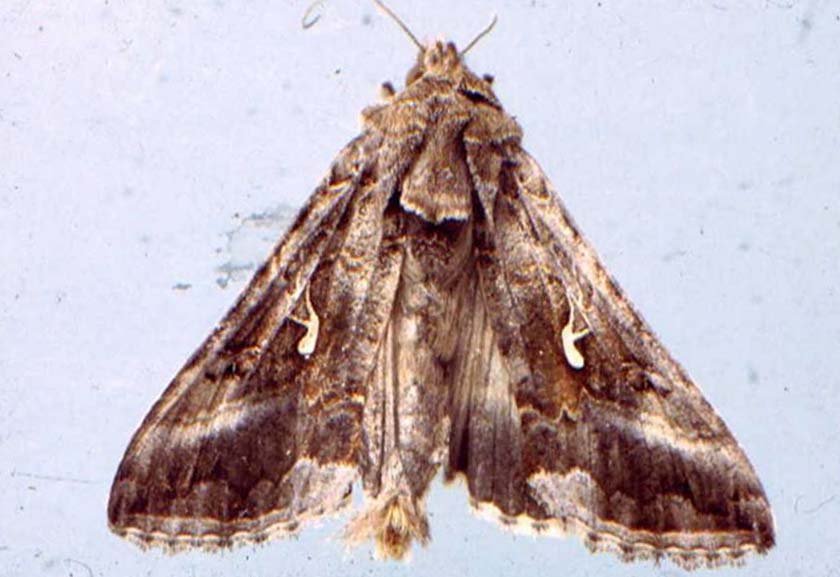 Full
FullGuide »

January 2025
Silver Y Moth
The caterpillar of the Silver Y moth feeds on foliage and pods and can cause a degree of defoliation when infestation levels are high. However, the main problem occurs when the caterpillar becomes a contaminant in vined peas, or when feeding damage to pods of fresh market peas or beans makes them unmarketable.
DESCRIPTION AND LIFE CYCLE
Adult moths are about 10 - 15 mm in length, have a brownish grey hairy body and greyish coloured wings, with a distinctive silver coloured y marking on each forewing. They can fly during the day or night and may be seen actively flying in crops during warm summer afternoons. They can often be found flying from plant to plant within the main foliage and at rest, often are seen with the wings folded back and rapidly ‘shivering’.
Most moths migrate to the UK during June, from Mediterranean countries or North Africa. Numbers are especially high following a periodof southerly winds that coincide with the main emergence of moths, resulting in large populations being dispersed around southernand eastern coastal areas. The moths feed onnectar and lay eggs singly or in pairs on the foliage. The eggs are white, round, flattened and about 0.5 mm in diameter. After 10 – 14 days,the eggs hatch and caterpillars begin feeding onthe leaves. At first, the damage appears as small discrete craters on the leaf surface, but as the caterpillars grow over the following two weeks,the damage becomes more extensive to both leaves and pods.
Caterpillars are bright green in colour varying in size up to 20 - 25 mm in length. There is a light-coloured thin stripe along the sides of the caterpillars, and they possess only two pairs of abdominal ‘pro-legs’ which allows them to move with a looping action. The caterpillar pupates in a shiny black chrysalis, contained by white webbing wrapped up in leaves or stems.

MONITORING
Silver Y moth migration is sporadic and because of this, populations vary between years, and it isdifficult to predict numbers in any one season. However, moths can be monitored using a pheromone trap available from Koppert UK: https://www.koppert.co.uk/challenges/caterpillars/silver-y-moth/; Andermatt UK: https://www.andermattuk.com/; and Agralan Ltd, www.agralan-growers.co.uk. Following work funded by the AHDB, PGRO developed the trap into a monitoring system which identifies the key risk of damage and contamination and the optimum time for applying control measures.
THE MONITORING SYSTEM
In peas, the trap is placed at crop height in the field in mid-May and moths, caught in the base, are counted on three occasions during each week of monitoring. A threshold is reached when a cumulative total of 50 moths has been reached by the time that the peas have reached the first pod stage (BBCH 67).
TIMING OF INSECTICIDES
When the threshold has been reached, a single spray of a pyrethroid insecticide, approved for pea moth control, should be applied 10 - 14 days later. This application will control both large and small caterpillars, which fall off the plants before the crop is harvested.
CONTROL IN BEANS
The same trap can be used in green beans or runner beans for monitoring populations although a threshold for treatment has not been formulated. However, where significant numbers of moths are caught regularly, crops should be inspected for caterpillars 7 - 14 days after first recording moths, and a spray applied where caterpillars can be found on crops which are about 7 days from harvesting.
INSECTICIDES FOR PEAS AND BEANS THAT WILL CONTROL SILVER Y CATERPILLARS
Insecticides approved for pea moth control in peas will control silver y moth caterpillars effectively. The Extensions of Authorisation for Minor Use for products containing lambda cyhalothrin for caterpillar control in green and runner beans are also effective for silver y caterpillar control.